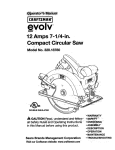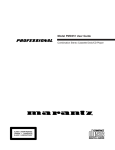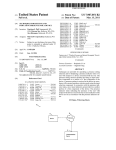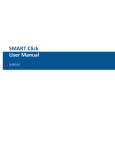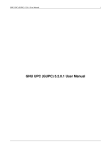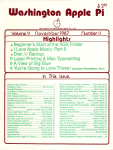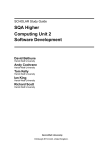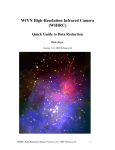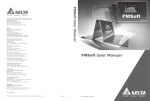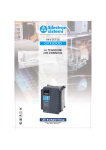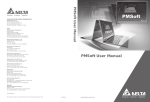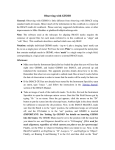Download CMU-ITC-90-104 4 January 1990
Transcript
CMU-ITC-90-104
4 January 1990
Enhancing documents with embedded programs:
How Ness extends insets in the Andrew ToolKit 1
Wilfred J. Hansen
Information Technology Center
Carnegie Mellon University
Pittsburgh, PA 15213-3890
Abstract:
An enhanced document responds to its reader in non-traditional
ways: a
button press may scroll the document, play music .....
Although such operations may be
implemented
as objects embedded in text, full generality requires that a programming
language be available to the author of a document.
This paper sketches the problems of
embedding
programs
in documents and reviews the solutions adopted in the Ness
component of the Andrew ToolKit. A key question is the connection from user actions to
program functions.
Other questions
include the appropriate
level of programming
language, its string processing capabilities, and security.
Traditionally
a computer document is an emulation of a paper one; it sits
reader to explore at will. This present paper is no different because even
writing it on a computer I expect most readers will view it on paper. But
were reading it at a computer;
how much more could it do? Simulations,
interactive examples, waving flags, music, fireworks?
there for the
though I am
suppose you
calculations,
The report below describes a system in which it is possible to write documents that have
most of these behaviors. In order to provide the most general environment, the system
incorporates a programming language, Ness, the design of which has been kept simple so
as to reach a broad range of authors. The underlying system is the Andrew ToolKit
(ATK).
Typical
applications
of such a system include
1(C) 1990 IEEE. Reprinted with permission, from Proceedings of IEEE Computer Society 1990 International Conference on Computer Languages, March 12-15, 1990, New Orleans, to appear.
Permission to copy without fee all or part of this material is granted provided that the copies are not made
or distributed for direct commercial advantage, the IEEE copyright notice and the title of the publication
and its date appear, and notice is given that copying is by permission of the Institute of Electrical and Electronics Engineers. To copy otherwise, or to republish, requires a fee and specific permission.
-2enhanced documents - with various
illustrate the points of the document
animations
and simulations
to
parameterized letter - after the user fills in a few fields in a form letter
other fields are calculated and the full letter is constructed
personal data
bibliography,...
base
-
addresses,
appointments,
course
records,
directory editor - click on a file to see its attributes or select it for moving
or deleting
system status monitor - a user builds a personal monitor for work station
status by selecting from a library of system measurement tools and a
library of ways to view dynamically changing values: dials, strip charts,
and so on.
dungeons and dragons - the description of the world is a large text through
which the reader can scroll; as the reader solves puzzles, descriptions of
new rooms and objects are added to the text.
The remainder of this paper discusses the system as though it were intended for
extending document: objects are inserted in the document at various places and their
behavior is controlled by a script written in the programming language. In all cases the
discussion applies equally well to programming an application; such a situation is just an
image that cannot be scrolled off the screen as parts of a document can. For documents
the substrate is a text; for applications the substrate is a drawing editor or some other
tool for laying out the contents of a window.
Hypertext documents can be created easily within a system that supports authorship of
enhanced documents. The author need only insert in the text a button extended to
respond to a button press by scrolling elsewhere in the same document or another. Nor is
the link constrained to always branch to the same place; the author can arrange the script
so the destination is chosen among several depending on what the reader has seen so far.
Because lengthy linear documents are possible, the Ness/ATK combination may reduce
the disorientation readers sometimes encounter in hypertext systems with small nodes.
The scroll bar in the view of the document serves as a visual indication of where the
current image is within the context of the entire document. See [8] for a good discussion
of the advantages of hypertext and references to the growing literature on user
disorientation.
Some discussion in the multi-media mail community has focussed on using a language to
describe mail documents. With this facility, new varieties of objects can be sent if the
receiving system has no more capability than the language interpreter. The work
reported below is both more and less general. It is not a language suitable for describing
any object, it assumes that a collection of objects will be available in the software of both
sender and receiver. It does, however, provide a language tailored for the author to
-3describe a myriad of different forms of interconnection and behavior of objects.
It is important to distinguish the notion of enhancing a document with a script from the
various authoring languages for educational tutorials (good examples are cT and Best
Course of Action; see [7]). With the latter, the author constructs a program which
generates a sequence of images; this contrasts with the enhanced document approach of
Ness where the program within the images. The crucial difference is in user control:
with an enhanced document the reader is in control and can employ ordinary text
operations to move through the text. With program generated images control lies with
the system; the reader can move only to where the system allows. Experience has shown
that it is not easy for authors to always imagine where readers will want to go in
reviewing a tutorial, so the reader many be sometimes stymied in trying to get to a
desired place.
The best known system with a programming language for enhancing what the reader sees
is Hypercard [1]. However, Hypercard operates in a far more limited environment: its
images are constrained to a certain small size and only two forms of object may be
embedded, buttons and fields. In contrast the system described below is implemented
within the far richer environment of the Andrew ToolKit, ATK. [5]
Underlying ATK is an object architecture, complete with inheritance of methods.
principle forms of object are
Two
data object - this provides for storage and manipulation of information;
every data object has at least the methods for writing the object to a data
stream and reading it back.
view - this provides user access to the contents of a data object by
displaying it in a rectangle on the screen; it also provides user interface
operations for scrolling or modifying the information.
The ATK architecture is specifically designed so that a view cannot know whether it
occupies an entire window or whether it is a subrectangle in another view. If a view has
embedded child views, the architecture provides for the parent view to completely
control the events seen by the child, thus views can be nested arbitrarily. To describe
what the user sees of the combination of view and data object, this combination is called
an inset. It is worth noting that the architecture proved sufficiently general that little
change to the underlying system was required to add Ness.
In starting Ness, it was not clear how script pieces should interface with insets and the
user. The many design alternatives are outlined in the next section and the following
section describes the choices made for Ness. A sketch of other facets of Ness--especially
the string algebra--is in the third section, followed by a discussion of security issues in
the last section.
-41. How can documents be enhanced?
Define an "extension" as a sequence of code to be executed at some particular time
during a user's perusal of a document. The principal semantic questions are
1) What sorts of events can trigger the extension?
2) What effect can the extension have on the containing
surrounding objects?
text and
It is apparent that in the usual workstation environment the set of events that can trigger
an extension must include user actions with the keyboard and the mouse. In ATK, an
important subset of mouse actions are selection from the popup menu. Another set of
trigger events are those defined by each inset class. For instance text objects may initiate
an event when some portion is selected or when the text scrolls, both of which may be
caused by any of several user actions.
In principle, inset-defined events would be a sufficient set of triggers. However, user
inputs are an important additional form of trigger because they enable the extension
language to deal with any object, whether or not it has been constructed with the
language in mind.
How is each object to be connected to the portion of the script which specifies the
response to events on that object? One answer to this is given by Hypercard, which
associates a script with each object. The difficulty with this approach is that scripts and
their functionality get scattered all over the place. In trying to understand what happens
in response to a mouse click on a button it may be necessary to look at as many as five
different scripts (button, card, background, stack, and home stack); and trying to
understand the interaction of several buttons requires looking at each in turn. The
situation is similar to the difficulties of trying to understand a spreadsheet of even modest
complexity [3].
In Ness all the scripts for a collection of objects are gathered together. Each object is
named and the extensions for an object appear together in a group identified with the
name of the object. Review of the script is thus reduced to looking in a single place,
though it is now not as easy to see which object each name refers to, especially if many
objects are extended. Ness authors can avoid this by using multiple scripts in the
document, one for each section. It is the author's responsibility to clarify as far as
possible the relation between script portions and objects.
A few people who have heard about Ness without seeing it have suggested that the script
ought to include not only the extensions but also textual descriptions of the objects
themselves. Among the claimed advantages are that the script could be editted with a
plain ASCII editor and that scripts could be generated by programs. Ness has taken a
very different approach. Construction of objects and their assembly into a document or
application are handled with the ordinary ATK object oriented editing facilities. If a
-5-
button is required in the upper left comer, the author puts a button there and it is
immediately visible, just as the reader will eventually see it. Ultimately ATK data
streams are indeed encoded in ASCII, so they can be editted with ASCII editors by
incorrigible hackers. It is also possible for a Ness script to insert an object in the
document or application. To select its size and place the script negotiates with the parent
inset inset which the object is inserted.
In a fully developed system there is a point to having representations of the objects in the
script so the author can click on one to request that it be highlighted in the document. At
present this is handled for Ness by an "arbiter" application, part of the mechanism that
handles naming of objects.
What can an extension do to its environment? A guiding principal of Ness is that the
instructions in an extension ought to have at least the same capabilities as the user sitting
at the workstation. Consequently, primitives are provided for simulating the user actions
of mouse hits, menu selections, and key strokes. In addition, each object makes available
a set of operations that Ness extensions may invoke.
One of the serious problems with allowing scripts to pretend to be the user is that ATK
permits users to alter the binding from keystrokes and menu options to function calls. If
the author writes a script which invoke the sequence ESC-N it may work for the author
but fail for others who have ESC-N bound to a different operation. The correct approach
is for the author to instead call the function which he or she has bound to the ESC-N key.
Functions behave the same for all users.
How does the extension script refer to objects in the environment? For each execution of
an extension there is one unique object, namely the one which triggered the extension;
this object can be referred to by a special name. There is also a special name for the text
in which the script is embedded; via this name the program can access any portion of the
document and any of its other objects. Most commonly, however, objects are referenced
by the same name which is used to associate extensions with objects.
2. The Ness 'Extend' construct
A Ness script is a sequence of attribute specifications: declarations of global variables,
global functions, and extend blocks. An extend block associates a set of contained
attributes with some named object. An extend block has the syntax:
extend <name>
<attributes>
end extend
-6-
where the <name> must be a string constant giving the name of an object.
There are situations in which it might make sense that the <name> value be an
expression rather than a constant and that the extend construction be executable rather
than a declaration. For instance an author may wish to have different extensions for an
object at different times. This design was not chosen for Ness because I felt that readers
and authors would be best served by a language with relatively "static" semantics; one
where the reader could tell what the program refers to without a great deal of poking
around the code. There could be confusion for some authors if they were allowed an
expression for <name>: they might not know when the expression would be evaluated or
whether a change in the value of the expression would cause the extend construct to refer
to a different object. Furthermore, the static nature of the extend construct helps suggest
to the author that the behavior of documents should be constant rather than dynamic;
once a reader has understood a given button, it should not change its behavior without a
clear cause. Nonetheless, a button can have differing behavior if an author really so
desires; the extension for the button need only test a global flag and behave differently
for different values.
Suppose the author wants to dynamically create an object and insert it in the document.
How can extensions be specified for it? With Ness this can be accomplished if the name
of the future object is pre-known. The <name> in the extend construct can refer to an
object which does not yet exist. When it is created, the extensions will be automatically
applied to it. For complete generality, however, it will probably be necessary to add to
Ness some form of executable extend operation.
In additional to declarations and function definitions, the attributes in a extend block may
include event specifications. Each such specifies a trigger event and a list of statements
to be executed when the event occurs. In a manner similar to the extend construct, an
event specification is a static declaration with the form
on <event-type> <specifier-string>
<statements>
end <event-type>
The <event-type>s are mouse, menu, keys, and event, where the first three intercept the
various user events and the fourth reacts to named events initiated by objects. The
interpretation of the <specifier-string>, which must be a constant, depends on the
<event-type>. For mouse it says which button is to be intercepted and whether the
interception is for the down stroke, movement while down, upstroke, or all of the above.
For menu and keys it specifies which operations are to intercepted or provided for the
user. In particular, the <specifier-string> for menu can add new options to the menu.
The statements for an on event are executed whenever the object extended (by the
surrounding extend construct) initates the event named by the <specifier-string>.
In writing Ness scripts one of the early discoveries is that intercepting a mouse hit means
that that hit will not go to the object. In one example, the object was a slider and the final
value, when the mouse is let up, is to be transferred to a computation. If the mouse is
-7-
intercepted, the slider will not change its value in response to the mouse, so the script
must perform an additional operation to tell the extended inset of the mouse change. A
built-in function in Ness provides for passing the event along to the inset.
Passing an intercepted event along to an inset may seem similar to the "pass" operation in
Hypercard, an operation that sends the current input message up the hierarchy to the next
level (button to card to stack to ...). However, in Ness and ATK events go down the
hierarchy so the bottommost object will not see the event at all if the surrounding script
so dictates. In our estimation, this gives the script and surroundings more control with
less special purpose code within the objects.
Naming of insets and interception of mouse, menu, and keystroke events is handled by
the cel and arbiter insets provided by the ADEW component of ATK [4]. These
mechanisms are outside the insets themselves, so their facilities can be utilized without
the collaboration of the subject inset. Cels and arbiters are both examples of wrapper
insets, ones which have a single child to which they allocate their entire screen space.
Each cel wraps around a simple inset like a button, so it can name the button and
intercept events. Each arbiter wraps around a substrate inset, like text, which can have
multiple embedded objects; from this vantage the arbiter collects the names from all
enclosed cels and makes the names available to Ness.
Since an arbiter wraps a substrate and a substrate may contain arbitrary insets, one
subinset of an arbiter may be another arbiter together with its own enclosed substrate,
Ness script, and collection of insets. So how does a script refer to objects in an arbiter
other than its own. It doesn't. At present, a Ness script can only refer to objects that
share the same surrounding arbiter as the script itself. This restriction could be
eliminated, but not without some difficulty. Consider the case where an author has
defined a simulation with a collection of named insets and a Ness script that refers to
them. Suppose then that the author inserts two copies of this simulation in a document. It
is only because each is surrounded with its own arbiter that name conflicts are avoided:
the Ness script in each simulation still refers to the local insets. As yet we have not
enough experience with Ness to suggest that a capability of referring to objects within
embedded arbiters is a necessary capability.
The statements within an on construct may refer to currentinset to refer to the inset
whose event has triggered the current execution; they may refer to inset(<string
expression>) to refer to the inset whose name is given by the <string expression>. Both
constructions yield objects as their values; objects on which it is possible to invoke two
classes of function that are defined in C code. First, the script may refer to methods and
instance variables of the object. Since this is not well protected and can lead to incorrect
behavior, it is discouraged, but there are situations in which it is crucial. More safely, the
script can call functions in what is called the proctable. Each inset defines a set of
procedures in this table, from which they are available to be called from Ness functions
or to be bound to keystrokes or menu options as a user customizes his environment.
-83. The String Algebra
Other than for string values, the Ness language is as simple and traditional as possible.
The seven statement forms currently implemented provide for variables, functions, and
flow-of-control, as sketched in Table 1 and illustrated in Appendix 1. Semicolons are
optional between statements. Parentheses are used only for function call and expression
nesting. Since it is implemented with ATK, programs may be typographically formatted
for clarity. There are five types of data in Ness: integer, real, boolean, object, and
marker. The first three of these are as in other common languages. An object value is a
pointer to an object; it is principally of use for values that are to be passed to methods
and proctable functions written in C.
variables
declaration:
assignment:
boolean p, q real x, y, z integer i, j
x := y + z p := not q or True
function
call: fix, p, i) sin(z)
return: return x + y exit function
flow-of-control: while-do, exit-while, if-then-elif-else
while i < j do
x:=x*2.5
if x > y then
exit while
end if
i:=i+l
end while
Table 1. The seven statement forms in Ness. Other flow-of-control
planned for the future.
statements are
String values in Ness had to differ from those in other languages for several reasons.
Most importantly, strings in any user-level language must be able to include full
typography--fonts, indentation, italic, non-ASCII characters, and so on--as well as
embedded objects. In a functional language it is also important that substrings be first
class objects which can be passed as arguments and returned as values. In other
programming languages it is difficult to write parsing and other string processing
functions because substring references are clumsy. If substrings are not an integral part
of the language, each substring reference needs three components: a reference to the
underlying string, an indication of the start of the substring, and an indication of the
length of the substring. It is possible to retain such values by keeping three separate
variables; it is even reasonable to pass them as arguments to functions. Returning such a
triple of values from a function, however, is awkward at best. The s_.uation is so bad that
it is difficult to see how to write a satisfactory string package as either a set of functions
-9-
or a preprocessor for C; the algebra needs to be incorporated as a fundamental part of a
language.
In Ness, marker values serve as string values. Each such value refers to a substring of
some underlying base string. In particular, for documents one base string will be the
document itself and a Ness script can refer to and modify an associated text via marker
values. A formal algebra underlies marker values, as detailed in [2], where it is proven
that the algebra is Turing equivalent. Within this algebra, constants and concatenation
serve traditional roles: each returns a marker value for an entire, newly-created string.
Five functions provide for all possible manipulations on strings: base(), start(), next(),
extent(), and replace(). See table 2.
base(s) - returns a marker for the entire base string underlying s
start(s) - returns a marker for the empty string which starts where s does
next(s) - returns a marker for the single character which starts where s
ends
extext(s, r) - returns a marker for the portion of the base between start(s)
and start(next(r)); if the latter precedes the former, the value is an
empty marker at start(next(r))
replace(s, r) - modifies the base string underlying s so the portion that s
originally referred to will contain a copy of the value initially in r
Table 2. The five primitive operations in the string algebra.
The string algebra solves other problems in addition to convenience in writing string
processing as function calls. The programmer need not be concerned with allocating
storage for strings because that is handled by the system. Strings are not restricted to the
array model found in some languages and programmers need not resort to integers,
pointers, or some other non-string data type in order to refer to substrings. Strings also
provide a data structuring form that may be more amenable to non-programmer
computation than traditional programming constructs which are designed more for the
convenience of hte machine than the human.
For data structuring, Ness markers provide not only string processing, but also all the
capabilities of structures and arrays. A string is a structure when it has multiple objects
embedded in it. It is an array when the embedded objects are all the same type and
integer subscription functions are used to access the object. It should be noted that
integer accessing does not reflect the majority of applications of arrays; in many
applications an array is accessed sequentially, varying the subscript by one at each step.
This corresponds to sequencing through a marker value with the next() function. For
non-sequential access, however, it is trivial to write a function in the string algebra to
- 10-
access the i'th element of a marker value, see Algorithm 1. In practice, this algorithm is a
primitive provided in the Ness system. (When it becomes common for users to store
marker value objects within strings, garbage collection will be necessary. At the moment
storage for the underlying strings is released when no markers refer to them.)
-- subscript(m, i)
-Returns the i'th element of m. If the length of m is
-less than i, the function returns an empty marker
-at the end of m. If i is less than zero the function
-returns an empty marker at start(m).
function subscript (m, i)
marker s
if i <= 0 then return start(m) end if
s := next(start(m)) -- first element of m
while extent(s, m)/= "" do
-- we are not at the end of m
if i = 1 then return s end if
s := next(s) -- next element of m
i:=i-1
end while
-- we are at the end of m
return start(next(m))
end function
Algorithm 1. The i'th element of a marker
typographical formatting of Ness code.
value. This example also illustrates
The desire for simplicity in Ness has led to a number of decisions to defer or not
implement popular semantic tools. The two major such decisions are that Ness is not
object oriented and functions are not first class objects. Ness does provide access to
objects, but these must be written in C as augmented with the class preprocessor [6]. If
functions were first-class, the extend functionality could be expressed as an assignment
to an attribute of the object extended. During the design it was felt that this provision
would make it possible to make more complex, less intelligible programs. For both
functions and object-orientedness, only experience will suggest whether we need to
augment the language.
Some observers have asked: should Ness be Lisp or be more like Lisp? One argument in
favor of Lisp is that it has "less" syntax. However, this argument does not hold up when
we notice that each "special form" in Lisp has its own unique syntax; and that there are
many more special forms in Lisp than language constructs in Ness Another argument for
Lisp is that it is a well known language. This is true, but the domain for Ness is so
different that a Lisp programmer must learn a new set of functions anyway; this set of
function names is a much higher hurdle to Ness than is the syntax of the language. A
-11-
final argument for Lisp is that lists are a convenient data structure which is simple to
learn. Ness counters this with the string algebra, which is just as powerful and may be
even more intuitive for non-programmers.
4. Security
Embedding of scripts in documents does not introduce a new level of security problem,
but makes more obvious a common security problem. The problem is that in small
operating systems when I execute a program written by someone else it may do anything
I myself may do; in particular, delete a file, modify a file, or send a copy of a file--say a
forth-coming examination--to an interloper, perhaps a student about to take that
examination. Since a Ness script is a program, and since it can do anything a user can,
its execution is a security loophole.
Hypercard offers a security level scheme of a sort: users may choose to execute at one of
five levels of privilege. However, these levels restrict the user from dangerous operations
while not restricting scripts; a script may even reset the level itself. One reason this is
not more of a problem in the Hypercard environment is that the equipment is less
frequently connected to networks. However, stackware is shared and we can expect virus
attacks via stackware in the future.
Some mainframe operating systems have implemented "capabilities", permissions that
can be granted to limit the operations available to programs. These would ease the
security problems, though they will still exist. Consider, for example, the user who
offers a brand-new spiffy shell which gives graphical access to files. This shell will have
to be given enough capabilities that it could be dangerous.
Ultimately the best and only protection is Trust; the reader must trust the person from
whom he or she got a document. In a small closed community, such trust is an important
factor in the free and open exchange of software. Unfortunately, the spread of
networking is widening our communities and exacerbating the security problems.
The Ness implementation has features that make it more difficult--though by no means
impossible--for a villain to damage an unwary user. 2 In particular, no script is ever
executed--or even compiled--without permission from the reader. Users may choose
among two options for this protection. The default option, automatically invoked for any
user who has not chosen otherwise, is that the Ness script is surrounded with a text that
describes the dangers of executing a script (see Appendix 2). The tail end of this text has
buttons which allow the reader several options, including that of Empowering the script,
which compiles the script and activates any extensions it specifies. To be absolutely sure
the user wants to empower the script, a click on the Empower button pops up a dialog
box asking whether the user really intends to empower the script.
2It maybe no surprisethat despiteconsiderableearlydesign workactual implementationof Ness security
beganNovember4, 1988,twodaysafterthe infamousMorrisintemetvirus.
- 12-
A villain should also be intimidated by the fact that Ness scripts are stored only in source
form. The villain cannot know which readers will take the time to examine the script
before empowering it, an examination which might ferret out any suspicious code. (Few
readers will read scripts in their entirety, but enough will to provide a deterent.) Such
examination of the code is aided by Scan, another option among the buttons at the end of
the warning text. This option compiles the script, but generates an error message for
each operation which might conceivably modify any of the reader's files, whether in
memory or on the disk. Without artificial intelligence, this scan is forced to be quite
paranoiac; it flags many statements which are completely harmless. Nonetheless, it
typically selects less than a fifth of all statements.
More experienced readers may wish a direct approach to empowering scripts. They may
specify in their personal preferences that they wish to see a dialog box instead of the
warning text. Then whenever a Ness appears for the first time the reader is presented a
dialog box which offers the same options as the buttons at the end of the warning text.
The necessity for security adds an unfortunate complexity. It would be preferable if
users did not have to know about the script and the notion of empowering it. Worse, the
requirement means that an author must position the script in such a way that it will be
visible on the screen, because otherwise the reader will never see it to Empower it. This
can clutter the design of applications with an unwanted element. In the future Ness and
ATK will have mechanisms to reveal the script at the outset and later hide it.
Evaluation
This paper has shown that document extension has considerable potential for bringing the
computer revolution to information delivery. It has described the Ness language which
permits an author to construct a document with a variety of behaviors.
The first problem in defining the interconnection of a language embedded in a document
is to identify those user events which initiate the operations described by the language.
With the extend construct, Ness associates event handlers with named insets. If the inset
signals appropriate events, they may be handled via the on event construct; otherwise the
script can intercept user events destined for the inset with the on menu, on mouse, and
on keys constructs.
Next the design must specify how the language can affect the document. One general
tool is to allow the script to perform all possible user operations. In addition, Ness
provides a full set of functions for manipulating insets, especially the text inset for which
Ness provides a string algebra.
Finally, the design must provide some control so nefarious authors are not as free to
produce programs which can damage readers' files. With Ness, the reader has the option
to empower a script or not and also the Scan mode which aids in reviewing the script for
potentially dangerous statements.
- 13Although apriori it may seem that enhanced documents would be excellent for mail, they
turn out not to be used in mail very much. The world of electronic mall is much more a
world of short immediate messages than it is a world of carefully crafted communication.
Plans for multi-media mail must satisfy the requirement for transmission of a variety of
kinds of bulk information--including scripts--but this will not be the majority of the
traffic.
A number of other lessons have been learned from this work:
o One can go quite far with static declaration of extends, events, and functions.
Simple scripts for enhancing documents do not seem to need a highly dynamic
language.
o Ness shows how to do extensions in a more comprehensible manner than
scattering scripts behind each individual object. By giving names to objects they
can be extended in the script and can serve as the targets of operations.
o The syntax of the extension language is far less a barrier to authors than is the
size of the library of functions available.
o Strings can be dealt with functionally with the string algebra. However, the
algebra is not as simple for non-programmers as could be hoped. The next step
will be to define a pattern matching language to see if this can make clearer the
description of string processing algorithms.
Ness is currently in daily use for maintenance of a data base of bugs and a bibliography.
Over time, the number of applications will grow; these will serve as the basis for a future
report.
- 14-
References
[1]
Hypercard User's Manual
(Cupertino, Calif.) 1987.
Publication
030-3081-A,
Apple
Computer
Inc.
[2] Wilfred J. Hansen, "The Computational Power of an Algebra for Subsequences",
Information Technology Center, Carnegie-Mellon Univ., 1989.
[3] Clayton Lewis and Gary M. Olson, "Can Principles of Cognition Lower the Barriers
to Programming?" Report on an informal workshop, University of Colorado,
July, 1986.
[4] Thomas P. Neuendorffer, "ADEW: The Andrew Development Environment
Workbench: An Overview", presented at the X Conference, Boston, M.A, 1989.
[5] Andrew J. Palay, Wilfred J. Hansen, et al., "The Andrew Toolkit - An Overview",
presented at the Usenix Conference, Dallas, TX, January, 1988.
[6] Paul G. Crumley, "The Andrew Class System", Information Technology
Carnegie Mellon University, file andrew/doc/Class.doc, 1989.
Center,
[7] Bruce A. Sherwood and Jill H. Larkin, "New tools for courseware production."
Journal of Computing in Higher Education, vol. 1, no. 1, pp. 3-20, 1989.
[8] Ben Shneiderman and Greg Kearsley, Hypertext Hands-On!, Addison-Wesley,
1989.
- 15-
Appendix 1: A Ness extended birthday card
After empowering the Ness in the birthday card below, the reader can click the mouse on
the cake; the card plays "Happy Birthday", shows the words, and lights the candle on the
cake.
Before:
Z
•
'
_
Happy
o
.el
01,
I
Birthday
Empower tim Ness (belou_) and click on t_ ca_ for Birtl_
Far best results, uze an IBM RTIPC workstction.
I+[,I,[,_
!!i!ii!
e.
2 greetings.
o o
- 16-
After clicking on the cake:
Happy Birthday
Happybirthday
toyou
Happy birthday,
Dear Nessie
Happy'
b/rthd_to
toyou
you
Happy
birdwIay
Empower tbe Hess (below) and deck on tbe cake/or
For best results, use an IBM RT/PC workstaZion.
Birt_a_a] greelings.
iil,.;',ill - H_py Birtk, dc_ to Hess l
;:::;
Done
One the next page is the Ness script for the birthday card. The image area at the top of
the card has two named insets: "visible cake" is the raster on the left and to its right is a
text inset called "song text". The "visible cake" inset is extended so mouse clicks on it
can be intercepted.
- 17 -
-- Happy
Birthday
to Ness !
boolean lit:= False -- "visible cake" is initially unlit
marker Cakes :="
extend "visible cake" on mouse "any"
if mouseaction = mouseleftup then
lit := not lit
if lit then
showcake(FirstObject(
second(Cakes)))
sing()
else
showcake(FirstObject(Cakes))
replace(base(currentselection
(inset("song text"))), "_")
end if
end if
end mouse end extend
function showcake(object cake)
raster_copy_subraster(cake)
raster_select_entire(inset("visible
cake"))
raster_replace_subraster(inset("visible
cake"))
raster_center_image(inset("visible
cake"))
end function
function sing()
marker m
m := last(base(currentselection(inset("song
text"))))
m := last(replace(m, 'NaHappy birthday to youXa"))
im ForceUpdate0
play_notes("L7 CC L4 DCF E P4")
m := last(replace(m, 'NaHappy birthday to youX,n"))
play_notes("L7 CC L4 DCG F P4")
im_ForceUpdate0
m := last(replace(m,
'_xnHappy birthday,_tDear NessieX,n"))
t'
""
- 18play_notesCL7 CC L4 >C <A FED P4")
im_ForceUpdate0
m := last(replace(m, "XnHappybirthday to youkn"))
play_notesCL7 A#A# L4 AF G F.")
end function
In function showcake, the raster__xxx0 functions are proctable entires defined by the
raster inset. The copy/replace sequence copies the cake to the cut buffer and then
replaces the visible cake with the new image.
The text inset named "song text" initially contains a blank and a newline. The expression
currentselection(insetCsong
text")) returns a marker value for the currently selected
portion of the text in this inset; this will usually be the empty string at the beginning. It is
immaterial which marker value is returned because the base() function is applied to the
value to get a marker for the entire contents of "song text".
im_ForceUpdate0
the text.
causes the display to update to make visible the preceding change to
The function play_notes0 is inserted in the proctable by a package which interprets notes
strings and plays them on the keyboard speaker in the IBM RT/PC.
- 19-
Appendix 2: The Warning to novices
The warning text given below is wrapped around a Ness script when it appears in a
document for user perusal. (The user may set a preference option to get a dialog box
instead. Such a user is presumed to know what he or she is doing.)
NESS - This inset is a Ness script. If you choose the empower option at the end of this
inset, the script may alter the behavior of this window. It may respond in new, useful,
exciting, or bizarre ways to your mouse clicks, keystrokes, and menu selections.
Warning: Empowering a Ness script is just like running a program. The author of
the script or program--if malicious--can write it in such a way that it can destroy
your files. If you do not trust the place or person from which you got this script, DO
NOT EMPOWER IT.
To learn what this script is supposed to do, you should read the surrounding document for
a description. Or, you can read the script itself if you are familiar with Ness. After
reading, you have four choices: do nothing, empower the script, "scan" it for potentially
dangerous statements, or change it. The last three options appear after the script.
To learn about Ness,
/usr/andrew/doc/ness.
give
the
command
'help
ness'
or
see
the
files
in
.... The Ness Script ....
<< the script is nested here >>
.... End of the Ness Script ....
Your Options
If you are uncertain whether to empower this script, the safest choice is to select NONE
of the options below.
Also safe is the Scan option, which you can choose if you are familiar with the Ness
language. The scan highlights each statement in the script which might conceivably
change this file or other files. After choosing the Scan option, select the Next danger
item on the Ness menu card to cycle through all the potentially dangerous statements.
If you know Ness and wish to modify the script, you can choose the Author mode
option. If you do so, this help text surrounding the script will vanish and you will be able
to edit the script. You can select the Add warning item on the Ness menu card to get
- 20 -
this help text back.
The final option is to decide to Empower this script. To do so means that you trust the
author of the script and the person who gave you this file; it also means you are aware
that the script may change how the system responds to your actions.
[
J
Scan for dangerous statements
Author mode - Let me edit the script
[
J
JEmpower- I trust the source of this script J




















